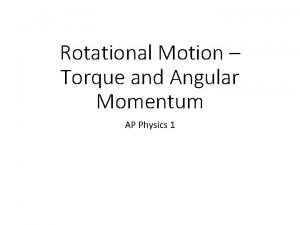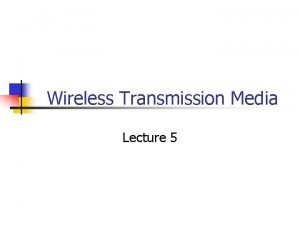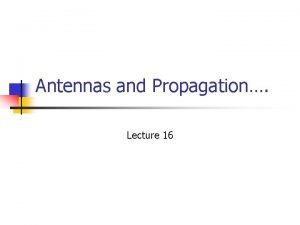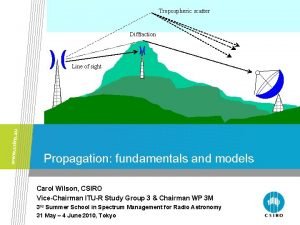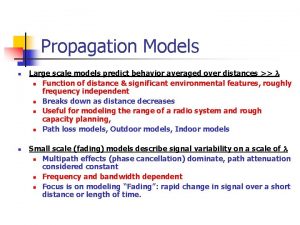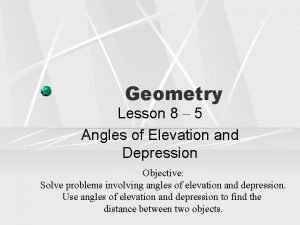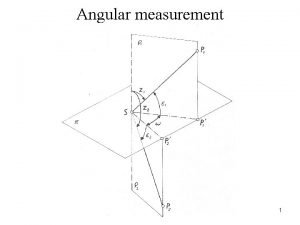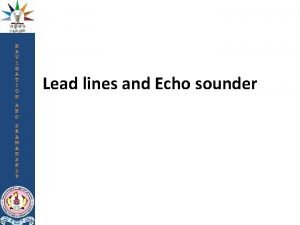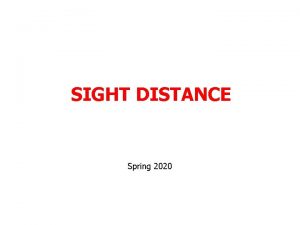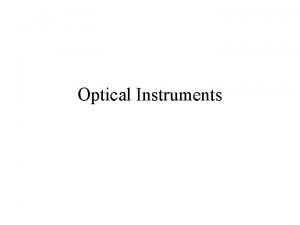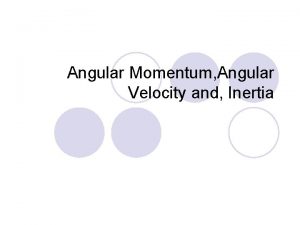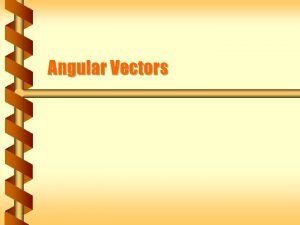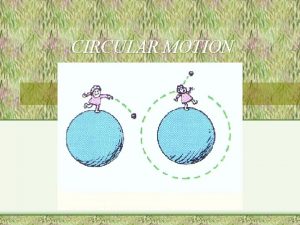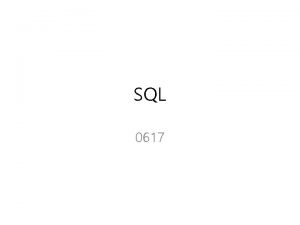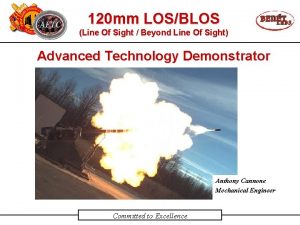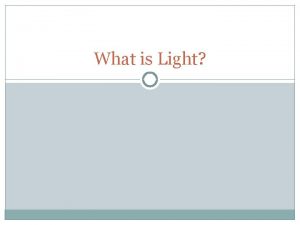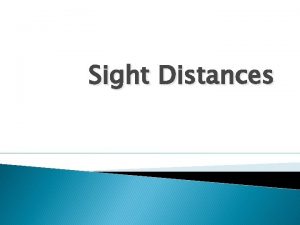Angular measurement 1 Line of sight the join






























- Slides: 30

Angular measurement 1

Line of sight – the join of the points S and P Horizontal direction – the intersection between the vertical plane i where is line of sight and the horizontal plane Horizontal angle ω – the angle between the vertical planes 1 and 2 (in the horizontal plane ) Zenith angle zi – the angle in the vertical plane i measured between the vertical and the line of sight 2

Units 1° = (π/180) rad 1 g = (π /200) rad Full angle Right angle 2 π π /2 360° 90° 400 gon = 400 g 100 gon = 100 g Sexagesimal x centesimal measure 3

Theodolites = instruments for angular measurements Classification with respect to a construction: • optical-mechanical theodolites • electronic theodolites – a distance meter is usually built-in (so-called total stations) 4

Classification with respect to accuracy: • one-minute theodolites – the least division of the scale is 1 or 2 minutes (sexagesimal or centesimal) • one-second theodolites – the least division of the scale is 1 or 2 seconds (sexagesimal or centesimal) 5

Optical-mechanical theodolite – parts Tripod Limbus Alidade 6

Optical-mechanical theodolite 7

Scales for reading of angles (one-minute theodolite) 8

Preparation of a theodolite for a measurement • levelling the alidade axis V of the instrument is vertical • centering the axis V goes through the survey station procedure of the instrument centering and levelling – see practical classes 9

Axes of theodolite Z – collimation axis (axis of the sight) V – alidade axis H – horizontal axis (telescope rotary axis ) L – level axis (axis of the alidade level) 10

Requirements for the axes 1. L V 2. Z H 3. H V Fulfilment of these requirements has to be tested an adjustment of the instrument has to be performed if it is necessary. 11

ad 1. if this requirement is not fulfilled, the alidade level has to be adjusted ad 2. if it is not realized collimation error measurement of horizontal angles in both positions of the telescope is used to avoid this error ad 3. if it is not realized error in incline measurement of horizontal angles in both positions of the telescope is used to avoid this error 12


Errors in the construction of a theodolite • an excentricity of the alidade – the axis V does not go through the centre of the horizontal circle. • an irregular dividing of the horizontal circle This error is not important at modern instruments. 14

Errors caused by standing of the instrument or the target • • wrong levelling of the instrument wrong centering of the target unstable tripod of the instrument It is not possible to avoid these errors by procedure of the measurement. 15

Errors caused by the observer • pointing error It depends on features of the telescope and the target, on the atmospheric conditions and on abilities of the observer. • reading error It depends on the least division of the reading scale and on the visual acuity of the observer. 16

Pointing 17

Measurement of a horizontal angle in one set 18

Procedure face left position 1. P 1 2. P 2 change the position of the telescope face right position 3. P 2 4. P 1 19

20

Measurement of directions set in one set with repeated pointing at the first point 21

Measurement of zenith angles A horizontal angle is the difference between two directions which are read on the horizontal circle (the difference between the left and the right target). A zenith angle is read on the vertical circle after pointing at a target (the direction to the zenith is given vertical). 22

The vertical circle rotates with tilting of the telescope and indexes of the reading scale are (or should be) in horizontal position during a measurement of the zenith angle. The correct position of the indexes is ensured by • collimation (index) level – older types of theodolites, • compensator – it works automatically (modern instruments). 23

The mentioned requirements for axes of theodolite have to be fulfilled during a measurement of zenith angles too. In addition to these requirements, a reading on the vertical circle should be 100 gon if the line of sight is horizontal. There is so-called index error if this requirement is not fulfilled. It is possible to avoid this error by measurement in both positions of the telescope and by calculation of a correction. 24

Measurement of a zenith angle in both positions of the telescope 25

If there is no index error, then z 1 + z 2 = 400 g If there is an index error, then z 1 + z 2 = 400 g + 2 i and the corrected zenith angle z = z 1 – i 26

27

Electronic theodolites • battery-powered (internal or external) • measured values are on the display (digital form) • some instruments have a built-in compensator of the alidade axis position • the correction of the index error can be introduced to measured values automatically • therefore it is often possible to measure only in the face left position of the telescope 28

• measured values can be recorded to the memory of the instrument • there are function buttons for setting of an arbitrary value of the horizontal circle reading, buttons for units option etc. • descriptive or numeral information can be inserted in memory of some instruments • some of the most modern instruments are motorized and then automatic pointing of the instrument is possible 29

Electronic theodolites 30
 Angular impulse-angular momentum theorem
Angular impulse-angular momentum theorem What is a wireless transmission media
What is a wireless transmission media Isotopic antenna
Isotopic antenna Line-of-sight
Line-of-sight Durkin's model
Durkin's model 8-5 angles of elevation and depression
8-5 angles of elevation and depression Angular measurement
Angular measurement Classification of surveying
Classification of surveying Hand lead line markings
Hand lead line markings Hát kết hợp bộ gõ cơ thể
Hát kết hợp bộ gõ cơ thể Frameset trong html5
Frameset trong html5 Bổ thể
Bổ thể Tỉ lệ cơ thể trẻ em
Tỉ lệ cơ thể trẻ em Gấu đi như thế nào
Gấu đi như thế nào Thang điểm glasgow
Thang điểm glasgow Bài hát chúa yêu trần thế alleluia
Bài hát chúa yêu trần thế alleluia Môn thể thao bắt đầu bằng từ chạy
Môn thể thao bắt đầu bằng từ chạy Thế nào là hệ số cao nhất
Thế nào là hệ số cao nhất Các châu lục và đại dương trên thế giới
Các châu lục và đại dương trên thế giới Cong thức tính động năng
Cong thức tính động năng Trời xanh đây là của chúng ta thể thơ
Trời xanh đây là của chúng ta thể thơ Mật thư anh em như thể tay chân
Mật thư anh em như thể tay chân 101012 bằng
101012 bằng Phản ứng thế ankan
Phản ứng thế ankan Các châu lục và đại dương trên thế giới
Các châu lục và đại dương trên thế giới Thơ thất ngôn tứ tuyệt đường luật
Thơ thất ngôn tứ tuyệt đường luật Quá trình desamine hóa có thể tạo ra
Quá trình desamine hóa có thể tạo ra Một số thể thơ truyền thống
Một số thể thơ truyền thống Cái miệng nó xinh thế chỉ nói điều hay thôi
Cái miệng nó xinh thế chỉ nói điều hay thôi Vẽ hình chiếu vuông góc của vật thể sau
Vẽ hình chiếu vuông góc của vật thể sau Biện pháp chống mỏi cơ
Biện pháp chống mỏi cơ
